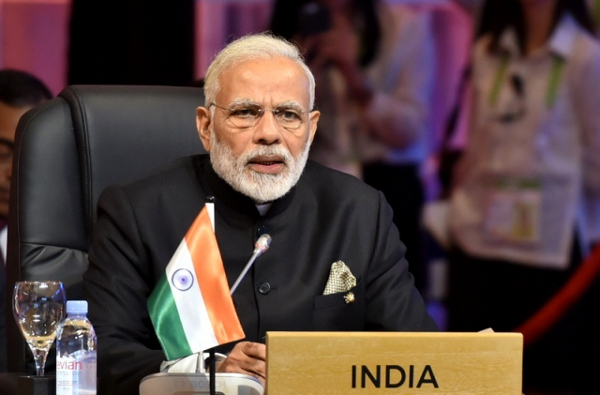New Delhi: If the working Group of Ministers’ suggestion on employment generation is implemented, India could soon have a ‘One Nation, One Address’, akin to an Aadhaar number, for every property.
Headed by Social Justice and Empowerment Minister Thaawar Chand Gehlot, the working GoM on employment generation and skill development submitted its report to Prime Minister Narendra Modi last month which said a unique, digital and scalable addressing solution for streets, buildings and units is required. ThePrint has a copy of the report.
Explaining how the system will work, the report suggested identifying and sequentially numbering streets using a fixed alphanumeric format. For instance, in a code like ‘AGC – 270 – 234’, AGC would be the area code/village code, followed by the street number (270) and the house number (234).
The report cited another example of this format, which was the New Delhi Municipal Council’s idea and has already tested it out.
“STS 100 138 instead of Mahaveer Shiva Shakti Mandir, Airport Authority of India, Safdarjung Airport Road, Satya Sadan, New Delhi, NCT of Delhi, 110003”.
However, there are challenges to this system, which the report pointed out — about 90 per cent of India’s streets do not have names or numbers, and addresses are in various formats.
“In recent decades, both urban and rural India has experienced extremely rapid growth. This growth has created many underserviced neighbourhoods. The street identification systems initially used in old neighbourhoods in the city/village centres have rarely been extended to new ones. Inadequate identification systems have created a worrisome predicament for urban and rural services,” the report noted.
“With no system of street coordinates, how do you find your way around a constantly growing city/village? How do we ensure ambulance/police reach on time? How can public and private services be provided in time and efficiently? How do you pinpoint breakdowns in water, electricity, and internet? How do you set up an efficient tax collection system?”
A senior government official told ThePrint: “It is estimated that many delivery persons waste 20% of their time locating the address and end up calling the person. Even drone delivery is not possible in India as there is no unique number in India for houses and properties. If we implement ‘One nation, One Address’, not only will it make delivery more efficient, but it will also help other key areas such as fire, ambulance and property tax among others.”
Problem areas GoM report identified
The report also said the current addressing systems are antiquated, inconsistent and broken.
“Poor addressing is expensive and negatively influencing multiple industries and government service delivery e.g. Emergency Services like Fire, Health & law enforcement. Street addressing and Door numbering is a key and basic infrastructure which has been overlooked.”
Further, it said 90 per cent of the consumer tech ecosystem in India depends on maps and addresses for location intelligence and reducing costs in delivery and planning. “Addressing has a large economic impact on the economy at large, some estimates peg it around a 10-Billion-dollar annual loss to the economy in the way of business inefficiencies and loss of life. India Post continues to lose to competition due to large dependence on Pin Codes. Disaster management and relief operations need maps and addresses for accurate planning.”
How One Nation, One Address can solve problems
The report said each village or locality in the city will get a unique alphanumeric code across the country.
“Street, Road, Building, Dwelling relations need to be established. No breakage in sequence due to rapid growth. Property mutations, aggregations, and future development of new areas to be considered. Provide APIs (Application Programming Interface) and support for emergency services and other service delivery. Enable record-keeping for departments such as Property Tax, Census, Emergency services, utilities, etc.”
The new system should be able to interact with all existing map providers to ensure a widespread adoption.
The idea has already been tested and implemented by the New Delhi Municipal Corporation, the Bhubaneswar Municipal Corporation and the Andhra Pradesh Urban in 110 local bodies.
If implemented, the system is also likely to create an estimated 2 crore jobs in the next five years in sectors such as the gig economy, surface transport, logistics, healthcare, hyper local markets, and government services delivered to the doorstep, with an impetus on women micro entrepreneurs. At the same time, it is likely to cost around Rs 1,125 crore (Rs 562 crore in year one and Rs 563 crore in year two).
The report further said this would lead to increased financial and administrative efficiencies across sectors, from property taxation, emergency response and disaster management, town and country planning and waste management to election management, grievance redressals, infrastructure planning and management and social transfers among others.
The report also details the process of implementation, which includes data collection, digitising existing imagery, auto identification of roads from imagery (satellite and drone imagery), digitisation of wards/village boundaries, identification of localities, city, village, locality code generation, unique street number generation, digital door number generation, survey by Census or IndiaPost, affixing stickers and digital door number generation among others.
Source: The Print
You may also like
-
Navigating India’s Skill Landscape
-
Trade Connect E-platform For Exports Is Single Window, Fast, Accessible And Transformational: Shri Piyush Goyal
-
India-us Working Together In Areas Like Critical Minerals, Supply Chains And Advanced Technologies: Shri Piyush Goyal
-
Cabinet Approves Health Coverage to All Senior Citizens of the Age 70 Years and Above Irrespective of Income
-
Cabinet Approves PM Electric Drive Revolution in Innovative Vehicle Enhancement (PM E-DRIVE) Scheme With An Outlay of ₹.10,900 Crore
